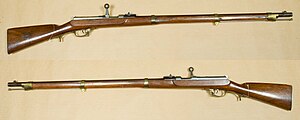Dreyse needle gun
| Needle Gun | |
|---|---|

M/41 Dreyse needle-gun ("leichtes Perkussionsgewehr M/41")
|
|
| Type | Bolt action |
| Place of origin | Prussia |
| Service history | |
| In service | 1841–1873 |
| Used by |
Prussia Romania Japan |
| Wars |
Austro-Prussian War, Second Schleswig War, Franco-Prussian war Romanian War of Independence |
| Production history | |
| Designer | Johann Nikolaus von Dreyse |
| Designed | 1836 |
| Variants | Infantry rifle M1841 Pikenbüchse M1854 Jägerbüchse M1856 Karabiner 1857 Fusilier M1860 Infantry rifle M1862 Württemberg Model 1857/67 Pioneer rifle M1869 Grenzaufsehergewehr 1870 Gendarmeriegewehr 1873 |
| Specifications | |
| Weight | 4.7 kg (10.4 lb) |
| Length | 142 cm (56 in) |
| Barrel length | 91 cm (36 in) |
|
|
|
| Cartridge | Acorn-shaped lead bullet in paper cartridge |
| Action | Breech-loading bolt action |
| Rate of fire | 10–12 rounds/min |
| Muzzle velocity | 305 m/s (1,000 ft/s) |
| Effective firing range | 600 m (650 yd) |
| Feed system | Single-shot |
| Sights | V-notch and front post iron sights |
The Dreyse needle-gun (German Zündnadelgewehr, which translates roughly as "ignition needle rifle") was a military breechloading rifle, famous as the main infantry weapon of the Prussians, who accepted it for service in 1841 as the "leichtes Perkussionsgewehr Model 1841" ("light percussion rifle Model 1841"), with the name chosen to hide the revolutionary nature of the new weapon. The name "Zündnadelgewehr"/"needle-gun" comes from its needle-like firing pin, which passed through the paper cartridge case to strike a percussion cap at the bullet base. The Dreyse rifle was also the first breech-loading rifle to use the bolt action to open and close the chamber, executed by turning and pulling a bolt handle. It has a rate of fire of about 10–12 rounds per minute.
The rifle was the invention of the gunsmith Johann Nikolaus von Dreyse (1787–1867) who, beginning in 1824, had conducted multiple experiments and in 1836 produced the complete needle-gun. Dreyse was ennobled in 1864.
The first types of needle-gun made by Johann Nikolaus von Dreyse were muzzle-loading, the novelty lying in the long needle driven by a coiled conchoidal spring which fired the internal percussion cap on the base of the sabot. It was his adoption of the bolt-action breechloading principle combined with this igniter system which gave the rifle its military potential, allowing a much faster rate of fire.
Although being accepted for service in 1841 it wasn't introduced into service in Prussia until 1848, then later into the military forces of many other German states, save for Austria. The employment of the needle-gun radically changed military tactics in the 19th century.
The needle-gun first made its appearance in street fighting during the May Uprising in Dresden in 1849. It also played an important role in the Second war of Schleswig in 1864. The rifle saw its heaviest use in the Austro-Prussian War of 1866. Because the breech-loader made it possible for a Prussian soldier to fire five (or more) shots, even while lying on the ground, in the time that it took his Austrian muzzle-loading counterpart to reload while standing, it was seen as allowing the Prussians to sweep the field. One observer proclaimed, "the needle-gun is the king."
...
Wikipedia
